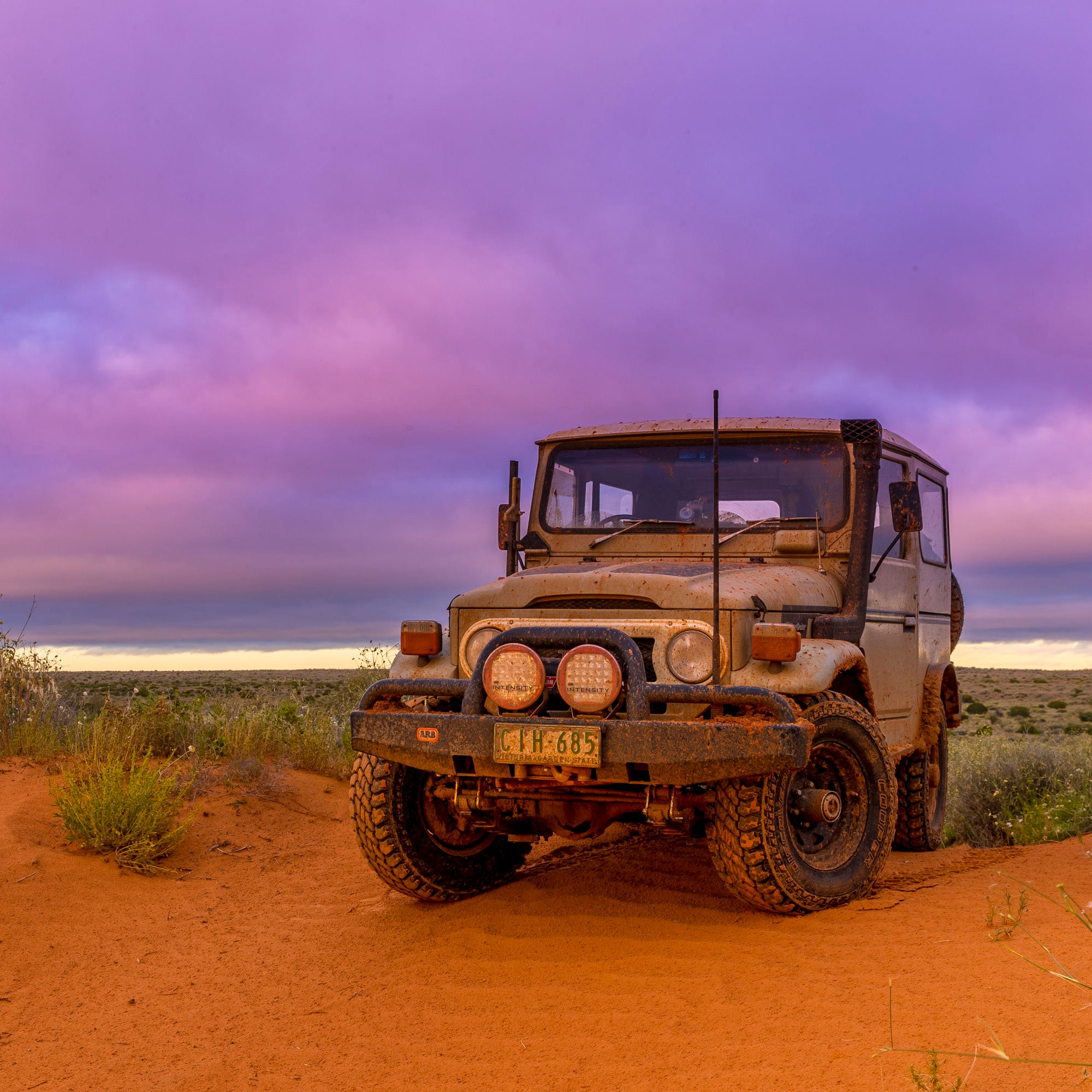If, like me, you’re a truck guy, then you’ve probably found yourself thinking, “Why don’t they make them like they used to?” In our minds, the simple, old-school construction of older pickups, SUVs, and 4x4s seems to endow them with a certain element of unstoppability in comparison to the complicated electronics and refined civility of the stuff made today.
IndefinitelyWild
 IndefinitelyWild is a lifestyle column telling the story of adventure travel in the outdoors, the vehicles and gear that get us there, and the people we meet along the way. Follow us on Facebook, Instagram, and Twitter.
IndefinitelyWild is a lifestyle column telling the story of adventure travel in the outdoors, the vehicles and gear that get us there, and the people we meet along the way. Follow us on Facebook, Instagram, and Twitter.But are older 4x4s actually better? Well, I think I just put that question to the ultimate test. Over the course of two weeks, I helped pilot eight trucks—four old, four new—across Australia’s Simpson Desert.
The Vehicles
Down Under, one name is synonymous with 4×4 adventure: ARB. It builds the suspension, locking differentials, bumpers, lights, luggage, and accessories that make going way, way off-road for long periods of time not just possible but also comfortable. This year is ARB’s 40th birthday: to celebrate, the company sourced four iconic trucks from Australia’s past and sympathetically restored and upgraded them specifically to complete this trip.
1976 Toyota FJ40 LandCruiser
During the construction of the Snowy Mountains Scheme—a hydroelectric and irrigation initiative that remains the largest engineering project in Australia’s history—an adequate source of Land Rovers could not be found. Japan is closer than England, so an importation deal for the LandCruiser was struck, and thousands of the vehicles were brought in to support construction in the rugged environment. This glut of reliable, capable 4x4s fueled the beginning of recreational off-roading in Australia. The LandCruiser is the first vehicle ARB ever made parts for. The FJ40 allowed people to travel to parts of the continent previously accessible only by camel, and many of that original batch of FJs can still be found working on remote farms today.
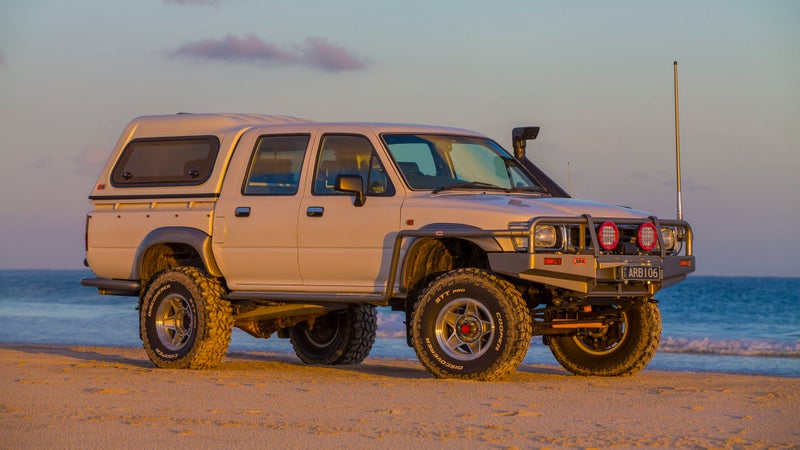
1994 Toyota HiLux
There is no vehicle more indelibly associated with off-roading in most parts of the world than the HiLux. Toyota made millions of the capable and extremely reliable pickups, and they still form the basis of most rebel armies in conflict zones worldwide. This fifth-generation model is fitted with a 2.8-liter, four-cylinder diesel producing a very low 90 horsepower in stock form. One of ARB’s first mods to this truck was a turbocharger.
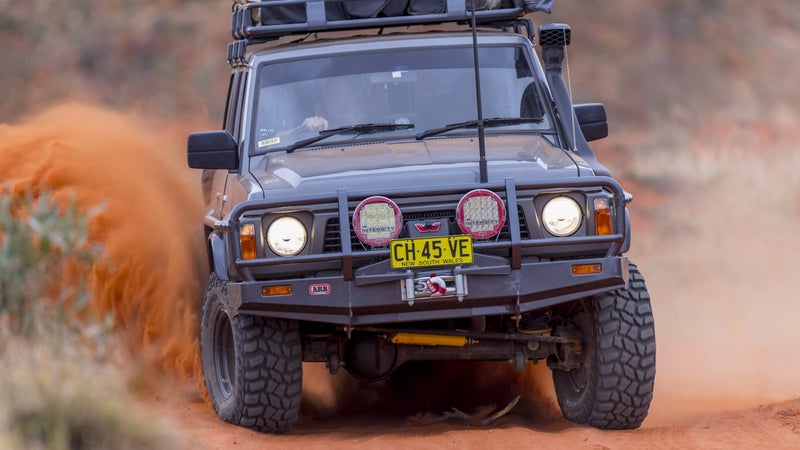
1989 Nissan Patrol
Never sold in America, the GQ-generation Nissan Patrol is legendarily strong. Its one-ton axles sit on highly articulating coil springs, and its 4.2-liter turbo diesel can easily be tuned up to 400 horsepower and beyond. This is a prototypical example of ideal truck specs and capability.
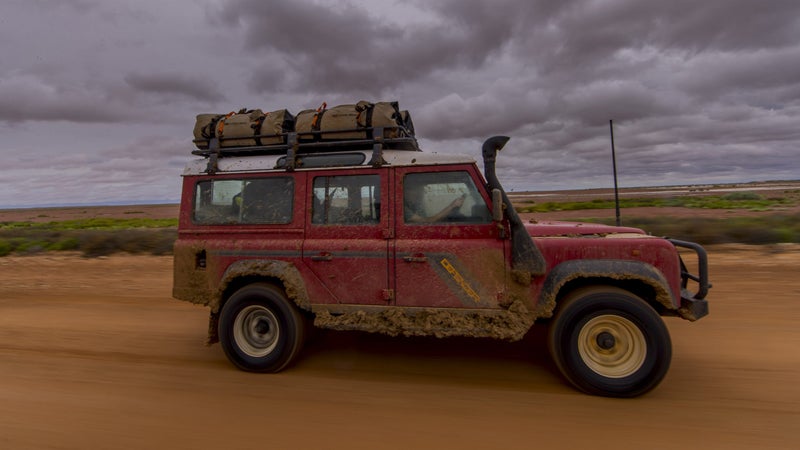
1995 Land Rover Defender 110
Gotta have a Land Rover. Produced for 67 years (in a few different versions), the Defender is responsible for both Land Rover’s legendary reputation for capability and its legendarily poor reputation for build quality. This vehicle was put together so badly that you could see daylight through the door seals, but it nevertheless proved an able, if agricultural, companion on the trip. This one was fitted with the lethargic, smoky, 2.5-liter turbo diesel.
You can read more about the history of and modifications made to these four iconic 4x4s here.

2016 Ford Ranger
Not sold in the United States, this Ranger is available in 180 foreign markets and represents the idea of a modern truck to most of the world. Rumor has it this platform will serve as the basis of the next-generation Ford Bronco and Ranger when they’re reintroduced to the American market. In contrast to the older vehicles, it has independent front suspension and an array of electronic driver aids, including many designed to help off-road. Its 3.2-liter turbo diesel puts out 197 horsepower and 346 pound-feet of torque while returning a combined 28 miles per gallon.
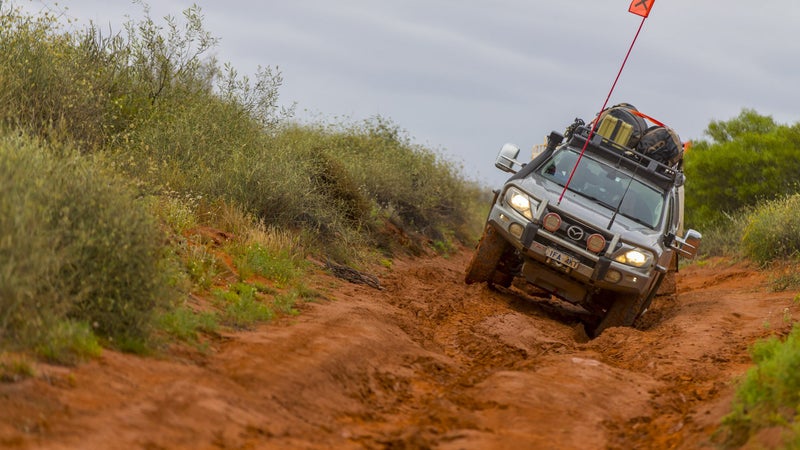
2016 Mazda BT-50
Mechanically identical to the Ranger, the BT-50 features more dramatic styling. This was our trailer hauler.
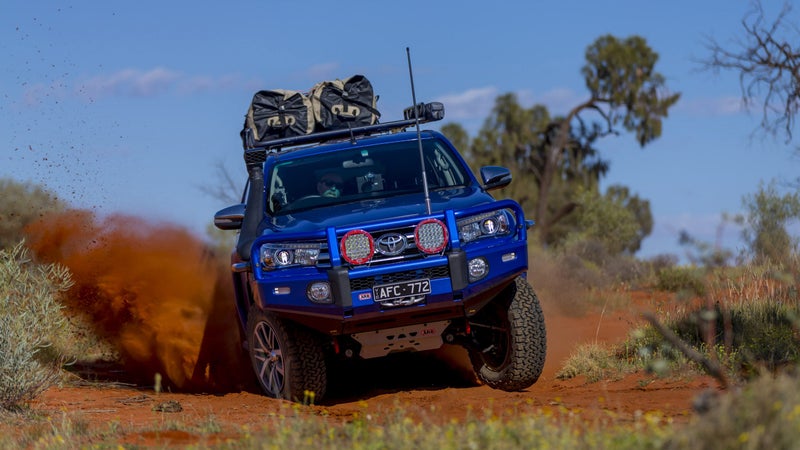
2016 Toyota HiLux
Similar to the Tacoma sold here in the States, the HiLux is available with torquier, more frugal diesel power plants.
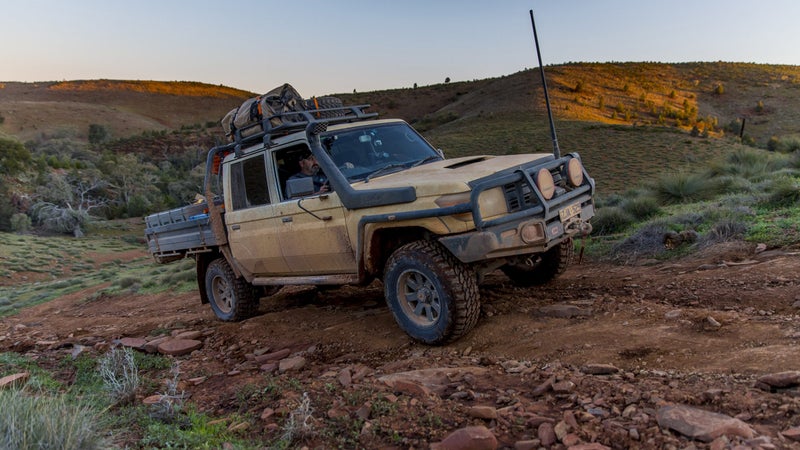
2016 Toyota FJ79 LandCruiser
Toyota gives foreign markets this exceptionally strong, practical, and capable pickup that’s fitted with a 4.5-liter turbo diesel V8 and live axles front and rear. A true utility vehicle, it can be found working equally well on construction sites, farms, off-road trails, and even carrying troops as part of many foreign armies. If there’s one truck that every American 4×4 enthusiast wishes were sold in America, it’s this one. The 70-series FJ makes every full-size pickup sold here look positively frail.
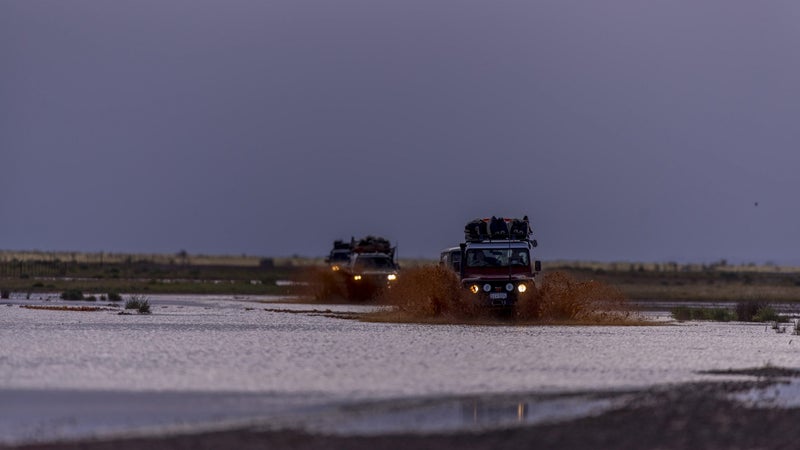
The Drive
The largest sand-dune desert in the world, the Simpson Desert spans central Australia and was first crossed by a white man—using camels—in 1936. From Alice Springs to Birdsville, our route carried us across 650 miles of it, including 1,133 sand dunes. Then we drove the famed Birdsville Track—sort of a dirt highway—for its entire 321-mile length before taking paved roads all 850 miles back to ARB’s headquarters in Melbourne. In total, faced with flooding, mud, and the incessant presence of flies, that took us two weeks.
Throughout the journey, we were self-sufficient. Obviously we had access to gas stations once we reached Birdsville, but the desert crossing was fueled by jerry cans, and we carried all our tools and spare parts, fixed the vehicles ourselves, and carried all our camping equipment, food, and beer.
This trip is one of the hardest challenges that can be completed by a 4×4 vehicle anywhere in the world and carried us to parts of the country the vast majority of Australian’s would never see. Doing it in older vehicles raised eyebrows on most people we met along the way or talked to about the trip afterward.
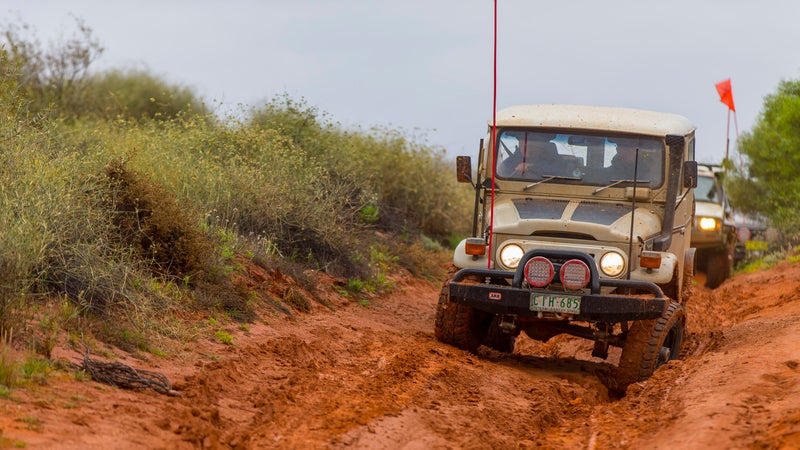
Challenges
Let’s break down the challenges we faced and determine which vehicles were most adept at meeting them.
Soft Sand
Driving up steep hills made from soft sand challenges a vehicle’s ability to find traction and its gearing to overcome sand clinging at the tires. The 1,133 sand dunes were not created equally, but the sheer number of them was an ever-present difficulty. The last dune of the trip was also the biggest. Standing 100 feet tall, Big Red attracts off-roaders from all over the country to tackle its steep slopes.
We had to cross Big Red late one night, on the last stretch of a long, exhausting day, with cold beers at the Birdsville pub waiting for us at the end. That day, nearly every vehicle had spent hours stuck in the mud, and the FJ40 was towed for more than 180 miles. We were tired, and all we wanted to do was get home, yet after fording windshield-height water at the dune’s base, I was unable to coax the powerful Patrol up the dune, even with both lockers engaged and in first gear, low range.
That first attempt was with the tires at 18 PSI; a second attempt at 12 didn’t go any better. Did I mention that my fuel gauge was reading below empty and our reserves were gone? I really wanted a beer, so a final attempt at 10 PSI got me up, but despite its torque advantage and very wide tires, the Patrol didn’t prove to be a terribly adept sand vehicle. Everyone else made it up on the first attempt.
Most Capable Vehicle: 2016 Ford Ranger. This was probably due more to its BF Goodrich All-Terrain K02 tires, which don’t break up the sand as much as mud terrains and allow the vehicle to float on top of it. But it still had the right gearing and plenty of torque to climb the dune uneventfully, time after time after time, when we returned the next day to play around.
Flooded Salt Pans
A thin layer of crunchy salt sits atop deep mud. During the dry season—when so many people have succumbed to exposure that it’s now illegal to visit the Simpson Desert during it—these form large, totally flat surfaces that can be driven across at extremely high speeds. These are similar, if smaller, to the Bonneville Salt Flats in Utah, where people race for land-speed records. But, man, when that mud underneath gets wet, these pans are a huge challenge. We faced bumper-deep mud with a slick bottom. With the mud pulling at the tires and no traction to be had, almost every vehicle got stuck, demanding we climb out, dig them free, and then use another truck to pull them out.
Most Capable Vehicles: Nissan Patrol GQ, Land Rover Defender, and Toyota FJ79. In the GQ, I was able to lock the differentials on both axles and just power through the deep mud, dramatically power-sliding the whole way. In contrast, the unfashionably narrow, lightly treaded all-terrains of the Defender cut through the mud and allowed it to slowly make its way across with only a locking rear differential. Heck, it even rescued the BT-50 once, complete with trailer. The FJ79, meanwhile, towed the FJ40 across a bunch of these flooded salt pans with nary an issue.
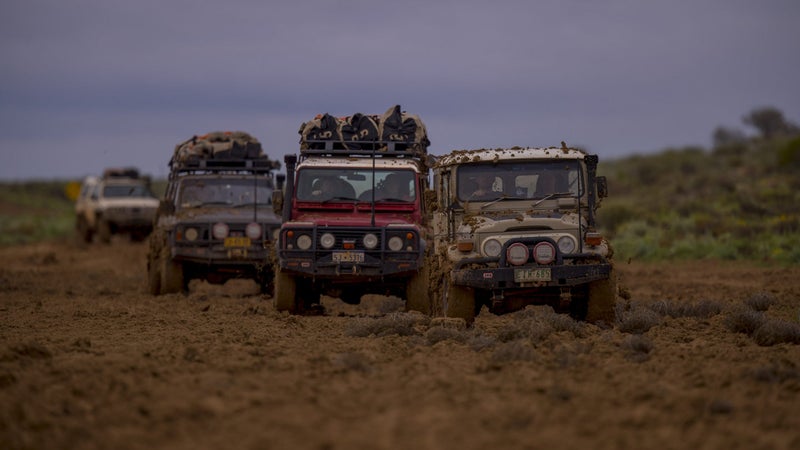
High Winds
With swags and other gear stacked high on the roofs of lifted trucks, the winds blowing across the Outback occasionally challenged the stability of our vehicles on the long, open tracks, while headwinds were sometimes strong enough to limit even our relatively modest speeds.
While trying to average 55 miles per hour in the 1994 HiLux into a headwind, we experienced engine overheating and were barely able to hold a constant speed. That was the only issue the HiLux experienced during the entire trip.
Most Capable Vehicles: Ford Ranger, Mazda BT-50, 2016 Toyota HiLux. The sleek, aerodynamic shapes of the most modern vehicles allowed them to cut through the wind without drama or loss of performance.
Muddy Tracks
Miles and miles of the Birdsville Track were muddy morass of deep tire tracks. We only just snuck through between closures. It was deep enough that the trailer would build its own berm of crud that would grind the Mazda to a halt every few miles, requiring that it be dug free, but everyone else was at least able to make forward, if slow, progress.
The slickness of the surface, complete with the tire grooves, created some unique issues. Driving the old HiLux—the lightest vehicle there—I had to lock both differentials to retain forward movement, but that led to wild power slides that would combine with the track’s deep ruts to spit me all across the road. Those are the conditions where you can roll a truck like this one. The Defender was again able to make steady progress, the FJ40’s torquey inline-six helped it keep going, and the GQ powered through, but the modern vehicles and their electronic safety systems actually proved to be best.
Most Capable Vehicle: 2016 Ford Ranger. It was able to find traction through slick conditions, and its stability control system kept it moving straight ahead, rather than sliding dangerously sideways.
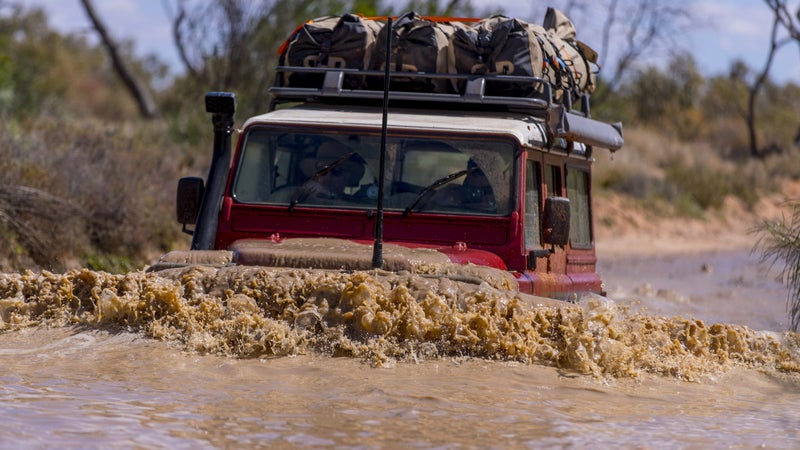
Deep Water
We encountered water crossings that reached the bottom of the windshield. All vehicles were equipped with snorkels, but the constant water ingress, along with the debris it would leave behind, borked the alternators on the GQ and Defender, while the FJ40 developed a recurring electrical problem that we were never able to fully diagnose. We’d get it running again (mostly), but it would stop again the next time it got wet.
Most Capable Vehicles: Everything modern, in addition to the 1994 HiLux, which developed no electrical issues of any kind.
Steep Climbs
All of the vehicles were geared correctly, so climbing steep, loose shale in low range wasn’t a huge issue. While you would have expected the torque-monster GQ to prevail here, its clutch began to slip midway through the trip, requiring careful driving afterward. The manual transmissions on the other older trucks also required a bit of care when climbing steep hills, whereas the automatics were comfortable creeping along at extremely low speeds without any care or attention required from the driver whatsoever.
Most Capable Vehicles: The 2016s.
Big Rocks
Recreational off-roading in the United States is defined by rocky terrain, which requires huge tires and massive articulation to overcome, but traveling through the Australian Outback gives you the opportunity to avoid such obstacles and focus instead on covering long distances through sand, mud, and dirt. So none of the vehicles were modified with rock crawling in mind, but there were still a few rocks to be found, and that’s where the superior articulation of solid axles was evident. The Nissan Patrol, in particular, with coil springs all around and very wide tires, made easy work of any articulation and grip issues we could find.
Most Capable Vehicle: Nissan Patrol. It’s simply the best platform for it here.
Curvy Roads
Not a traditional off-road obstacle but something you need to deal with in any road-legal vehicle, paved corners challenge any 4×4. Because our trucks were built for long-distance travel by experienced engineers working for a company that specializes in safety, none of them had a huge problem with even high-speed sweepers. Even the FJ40 was fun and safe to drive on winding mountain roads. But with independent front suspension, ABS brakes, more powerful motors, and electronic driver aids, the modern vehicles performed in a superior fashion. Chasing the BT-50 one night in the GQ, I was barely able to keep the Mazda in sight, and I have a background in high-performance driving.
Most Capable Vehicles: 2016 Toyota HiLux, Mazda BT-50, Ford Ranger.

Highways
When you lift a truck, put on big tires, and lower the gearing, you’re limiting its performance, worsening its ride, ruining its fuel economy, and potentially making it unsafe during high-speed maneuvers on grippy surfaces. Just putting in a full day on the highway, passing trucks, and dealing with traffic are as challenging to these vehicles as anything they’ll encounter off-road. And with their independent front suspension, six-speed transmissions, sound-deadening features, good stereos, aerodynamic shapes, and other modern conveniences, you cannot argue the superiority of a modern truck design in this environment. Even lifted and even on larger tires, they all managed to track in a straight line with the driver’s hand off the wheel. The older trucks all wandered around the highways like ships at sea.
Most Capable Vehicles: 2016 Toyota HiLux, Mazda BT-50, Ford Ranger.
Reliability
Let’s go through the problems the vehicles experienced one by one. The FJ40, well, it broke at least a hundred times. In addition to the electrics, it was the clunky mess you’d expect of a 40-year-old vehicle, even one fettled by mechanics before the trip. The 1994 HiLux’s only problem was when it overheated while being driven hard into a headwind. The Patrol’s alternator broke and necessitated replacement despite a few attempts at field repair. The Defender did better than anyone expected, only spewing grease constantly from its rear-wheel seals and suffering a temporary alternator malfunction when that was jammed full of mud. But you could see the sky through the door seals, the rear door wouldn’t stay closed, and nothing really worked inside, including the dash lights. Driving it was like driving a school bus that refuses to get stuck. The Ranger’s front sway bar fell off one day. The modern HiLux’s plastic wheel-well liners kept falling off. The FJ79 shed its right rear wheel and its studs while traveling at speed, luckily just a few yards before hitting pavement.
Most Capable Vehicle: Mazda BT-50. The trailer it was towing had its own problems, but that the Mazda crossed the desert while towing it without a single issue is extremely impressive.

Old or New Off-Road?
Only proving more capable than the modern vehicles in two categories—one of which was a tie with the FJ79—the older vehicles are inarguably an inferior choice for an extremely challenging off-road trip like this one.
The relatively limited articulation of independent front suspension did not, at any point, prove a limiting factor. Had there been obstacles that the modern trucks equipped with it couldn’t have handled, those vehicles most likely could have simply driven around them.
The relative complexity and electronics-heavy approach of modern truck design may, in theory, be harder to repair in the field, but it also proves so much more reliable that it’s just not a huge concern.
Many people also complain about the size of modern vehicles, but here that again proved a boon: the modern trucks carried much more than their forebearers and did so with fewer issues.
I say this as the owner of an old solid-axle 4×4: you simply cannot argue the objective superiority of modern technology and conveniences. Modified appropriately, a modern truck is just as capable.
One of the takeaways from all this, at least for me, is that we should be pretty excited about the U.S. launch of the Bronco, and the Ranger it’s based on, in 2020. We’ll be getting exceptionally capable vehicles that are still tough enough to handle grueling off-road challenges like this one. Not only that, but we’ll also be getting exceptionally capable off-road vehicles that already have total parts support with a proven track record.
But the most fun 4×4 to drive? That was clearly the FJ40. It took the most work for the least speed, wore us out, and kicked our butts, but all that also endeared us to the truck in a way the more modern stuff just couldn’t manage. A lot of that rosy memory is probably due to shipping it home from the edge of the desert so none of us would have to suffer in it for two long days on the highway.

